Taxation Ruling TR 98/17 and Residency Status in Australia
VerifiedAdded on 2023/06/07
|12
|2382
|166
AI Summary
The letter provides information on Taxation Ruling TR 98/17 and how it determines residency status in Australia. It also offers advice on taxable income based on transactions and negative gearing regulations. The letter includes references to relevant sections of the ITAA 1936 and ITAA 1997. Course code, course name, and college/university are not mentioned.
Contribute Materials
Your contribution can guide someone’s learning journey. Share your
documents today.
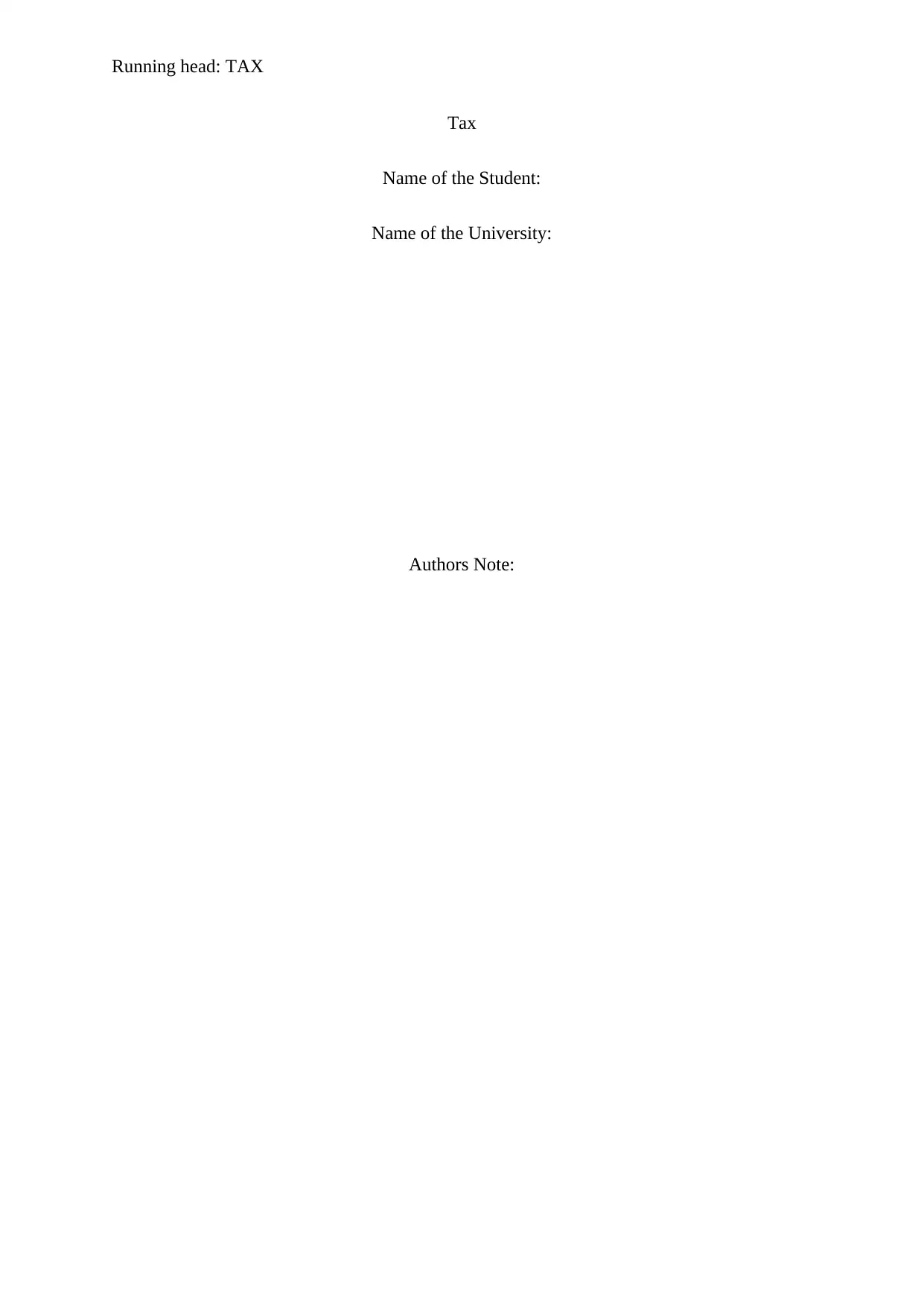
Running head: TAX
Tax
Name of the Student:
Name of the University:
Authors Note:
Tax
Name of the Student:
Name of the University:
Authors Note:
Secure Best Marks with AI Grader
Need help grading? Try our AI Grader for instant feedback on your assignments.

1
TAX
Table of Contents
Part 1..........................................................................................................................................2
Part 2..........................................................................................................................................5
A)............................................................................................................................................5
B)............................................................................................................................................8
Reference..................................................................................................................................10
Part 1
TAX
Table of Contents
Part 1..........................................................................................................................................2
Part 2..........................................................................................................................................5
A)............................................................................................................................................5
B)............................................................................................................................................8
Reference..................................................................................................................................10
Part 1
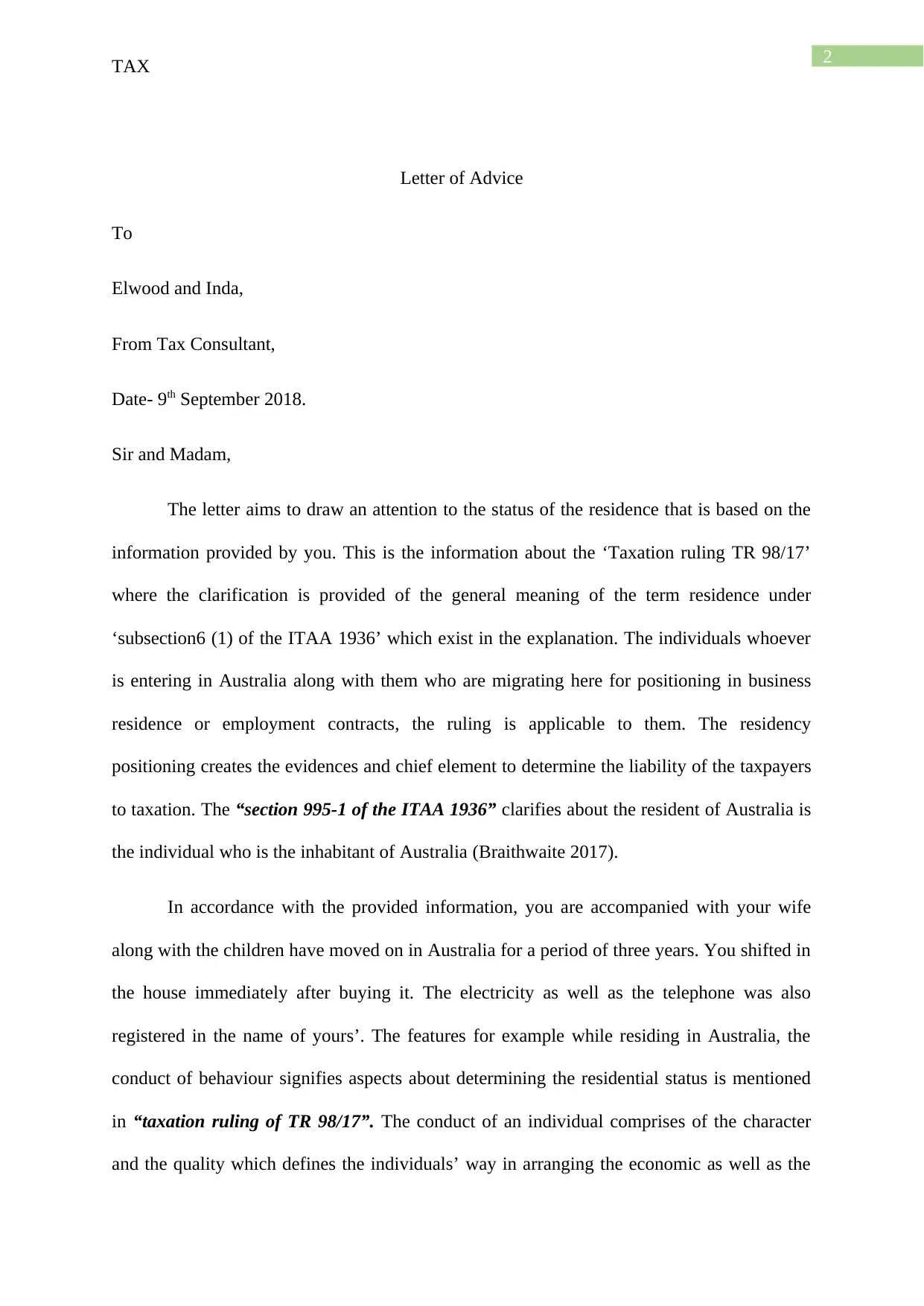
2
TAX
Letter of Advice
To
Elwood and Inda,
From Tax Consultant,
Date- 9th September 2018.
Sir and Madam,
The letter aims to draw an attention to the status of the residence that is based on the
information provided by you. This is the information about the ‘Taxation ruling TR 98/17’
where the clarification is provided of the general meaning of the term residence under
‘subsection6 (1) of the ITAA 1936’ which exist in the explanation. The individuals whoever
is entering in Australia along with them who are migrating here for positioning in business
residence or employment contracts, the ruling is applicable to them. The residency
positioning creates the evidences and chief element to determine the liability of the taxpayers
to taxation. The “section 995-1 of the ITAA 1936” clarifies about the resident of Australia is
the individual who is the inhabitant of Australia (Braithwaite 2017).
In accordance with the provided information, you are accompanied with your wife
along with the children have moved on in Australia for a period of three years. You shifted in
the house immediately after buying it. The electricity as well as the telephone was also
registered in the name of yours’. The features for example while residing in Australia, the
conduct of behaviour signifies aspects about determining the residential status is mentioned
in “taxation ruling of TR 98/17”. The conduct of an individual comprises of the character
and the quality which defines the individuals’ way in arranging the economic as well as the
TAX
Letter of Advice
To
Elwood and Inda,
From Tax Consultant,
Date- 9th September 2018.
Sir and Madam,
The letter aims to draw an attention to the status of the residence that is based on the
information provided by you. This is the information about the ‘Taxation ruling TR 98/17’
where the clarification is provided of the general meaning of the term residence under
‘subsection6 (1) of the ITAA 1936’ which exist in the explanation. The individuals whoever
is entering in Australia along with them who are migrating here for positioning in business
residence or employment contracts, the ruling is applicable to them. The residency
positioning creates the evidences and chief element to determine the liability of the taxpayers
to taxation. The “section 995-1 of the ITAA 1936” clarifies about the resident of Australia is
the individual who is the inhabitant of Australia (Braithwaite 2017).
In accordance with the provided information, you are accompanied with your wife
along with the children have moved on in Australia for a period of three years. You shifted in
the house immediately after buying it. The electricity as well as the telephone was also
registered in the name of yours’. The features for example while residing in Australia, the
conduct of behaviour signifies aspects about determining the residential status is mentioned
in “taxation ruling of TR 98/17”. The conduct of an individual comprises of the character
and the quality which defines the individuals’ way in arranging the economic as well as the
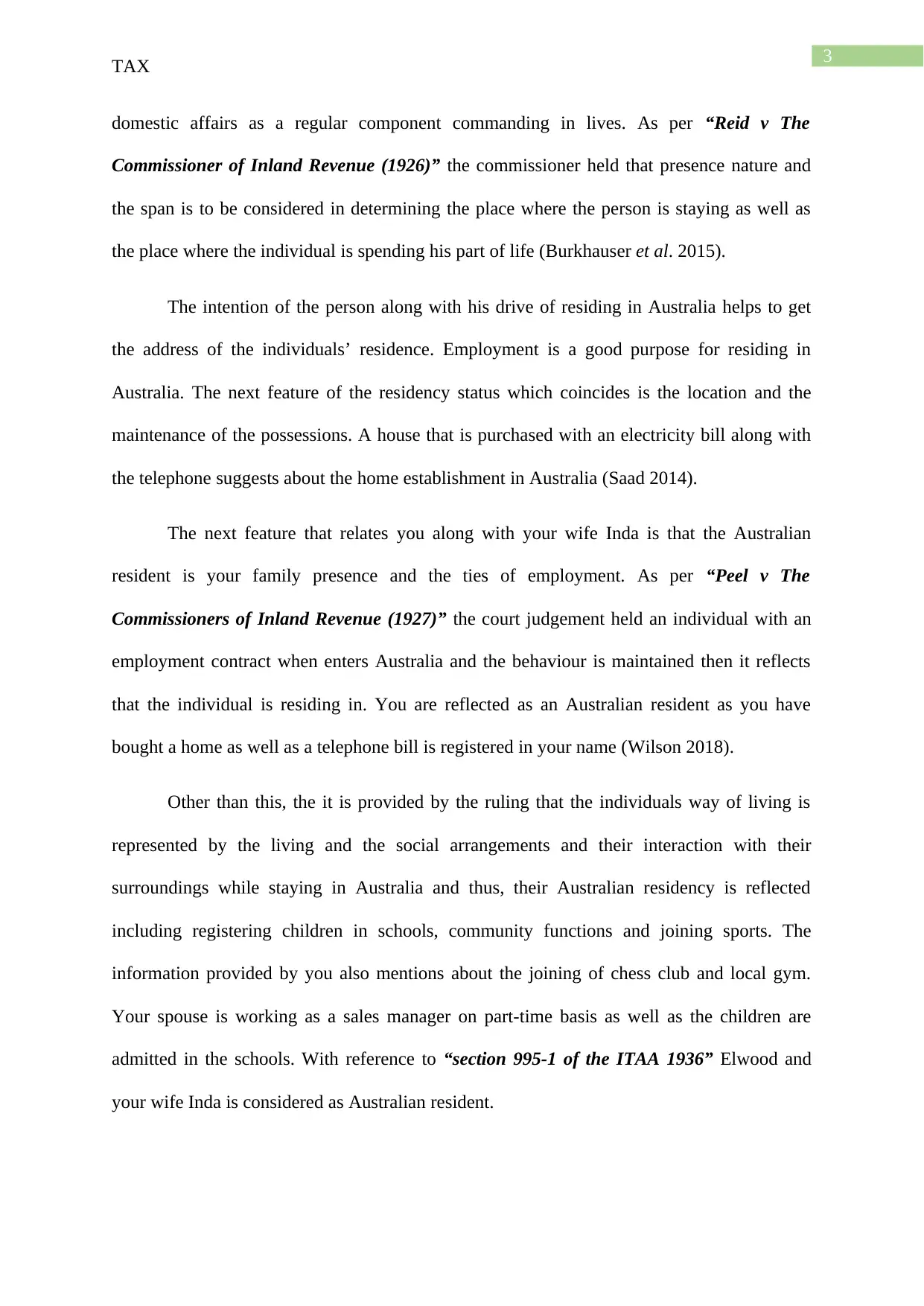
3
TAX
domestic affairs as a regular component commanding in lives. As per “Reid v The
Commissioner of Inland Revenue (1926)” the commissioner held that presence nature and
the span is to be considered in determining the place where the person is staying as well as
the place where the individual is spending his part of life (Burkhauser et al. 2015).
The intention of the person along with his drive of residing in Australia helps to get
the address of the individuals’ residence. Employment is a good purpose for residing in
Australia. The next feature of the residency status which coincides is the location and the
maintenance of the possessions. A house that is purchased with an electricity bill along with
the telephone suggests about the home establishment in Australia (Saad 2014).
The next feature that relates you along with your wife Inda is that the Australian
resident is your family presence and the ties of employment. As per “Peel v The
Commissioners of Inland Revenue (1927)” the court judgement held an individual with an
employment contract when enters Australia and the behaviour is maintained then it reflects
that the individual is residing in. You are reflected as an Australian resident as you have
bought a home as well as a telephone bill is registered in your name (Wilson 2018).
Other than this, the it is provided by the ruling that the individuals way of living is
represented by the living and the social arrangements and their interaction with their
surroundings while staying in Australia and thus, their Australian residency is reflected
including registering children in schools, community functions and joining sports. The
information provided by you also mentions about the joining of chess club and local gym.
Your spouse is working as a sales manager on part-time basis as well as the children are
admitted in the schools. With reference to “section 995-1 of the ITAA 1936” Elwood and
your wife Inda is considered as Australian resident.
TAX
domestic affairs as a regular component commanding in lives. As per “Reid v The
Commissioner of Inland Revenue (1926)” the commissioner held that presence nature and
the span is to be considered in determining the place where the person is staying as well as
the place where the individual is spending his part of life (Burkhauser et al. 2015).
The intention of the person along with his drive of residing in Australia helps to get
the address of the individuals’ residence. Employment is a good purpose for residing in
Australia. The next feature of the residency status which coincides is the location and the
maintenance of the possessions. A house that is purchased with an electricity bill along with
the telephone suggests about the home establishment in Australia (Saad 2014).
The next feature that relates you along with your wife Inda is that the Australian
resident is your family presence and the ties of employment. As per “Peel v The
Commissioners of Inland Revenue (1927)” the court judgement held an individual with an
employment contract when enters Australia and the behaviour is maintained then it reflects
that the individual is residing in. You are reflected as an Australian resident as you have
bought a home as well as a telephone bill is registered in your name (Wilson 2018).
Other than this, the it is provided by the ruling that the individuals way of living is
represented by the living and the social arrangements and their interaction with their
surroundings while staying in Australia and thus, their Australian residency is reflected
including registering children in schools, community functions and joining sports. The
information provided by you also mentions about the joining of chess club and local gym.
Your spouse is working as a sales manager on part-time basis as well as the children are
admitted in the schools. With reference to “section 995-1 of the ITAA 1936” Elwood and
your wife Inda is considered as Australian resident.
Secure Best Marks with AI Grader
Need help grading? Try our AI Grader for instant feedback on your assignments.
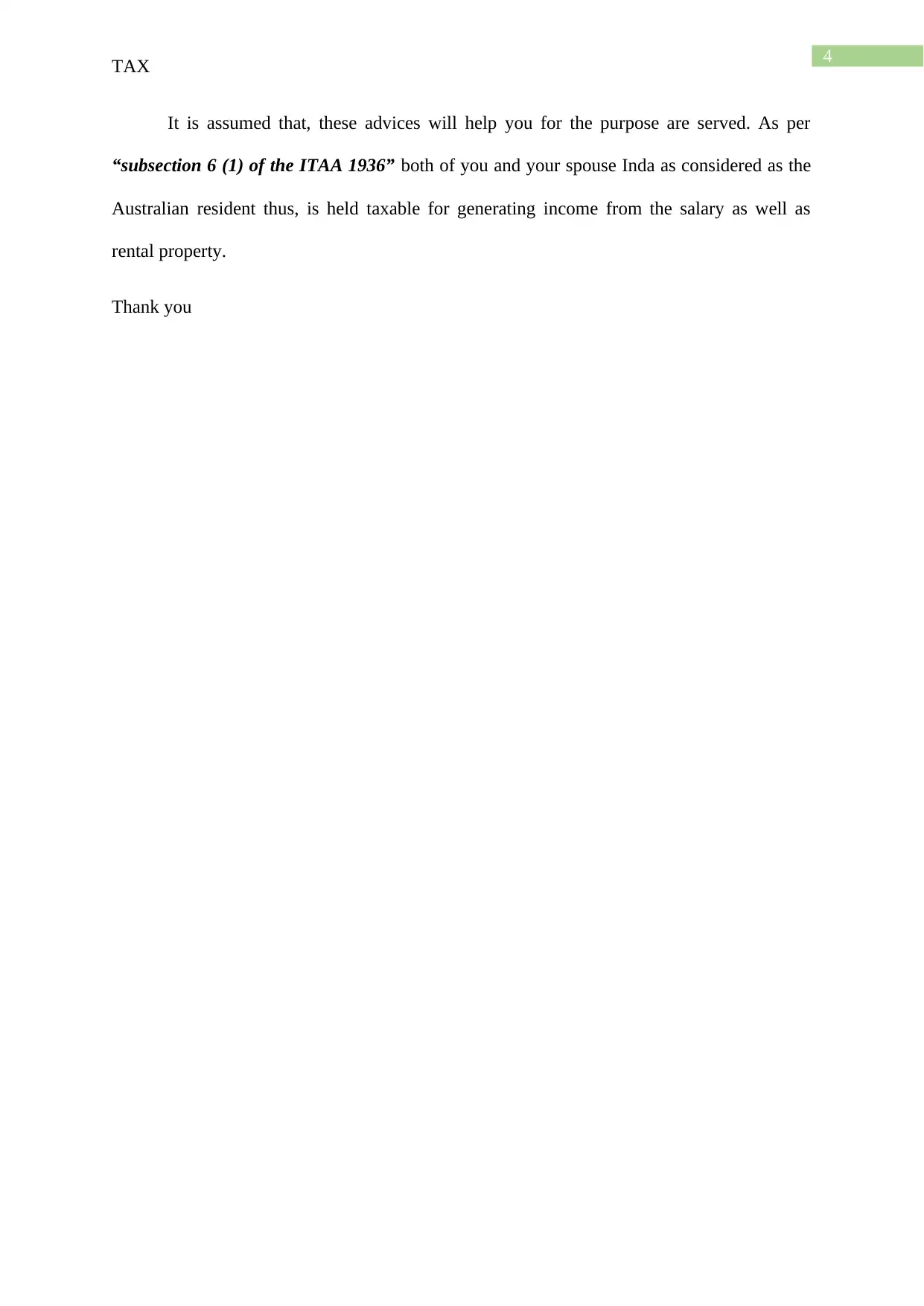
4
TAX
It is assumed that, these advices will help you for the purpose are served. As per
“subsection 6 (1) of the ITAA 1936” both of you and your spouse Inda as considered as the
Australian resident thus, is held taxable for generating income from the salary as well as
rental property.
Thank you
TAX
It is assumed that, these advices will help you for the purpose are served. As per
“subsection 6 (1) of the ITAA 1936” both of you and your spouse Inda as considered as the
Australian resident thus, is held taxable for generating income from the salary as well as
rental property.
Thank you
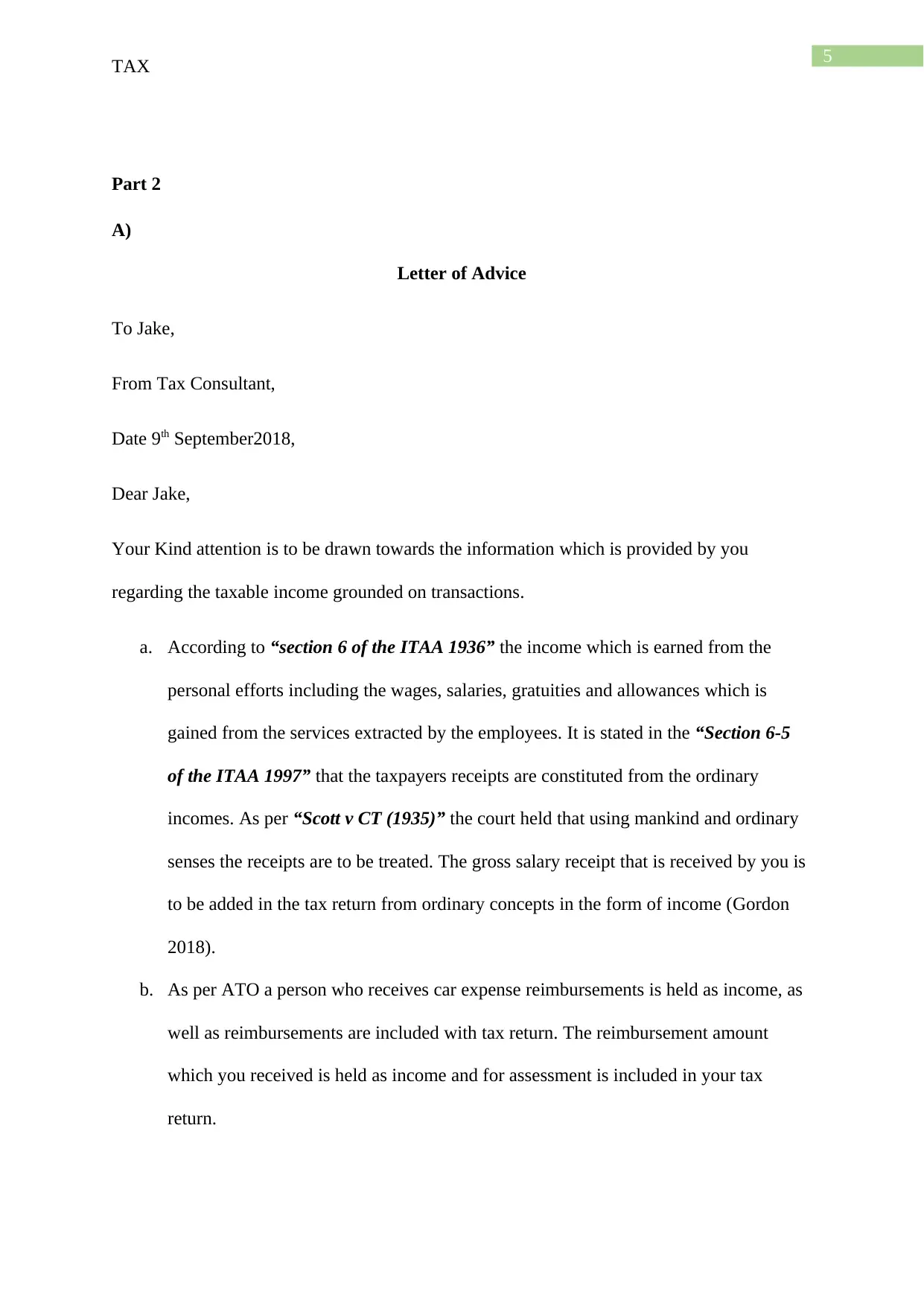
5
TAX
Part 2
A)
Letter of Advice
To Jake,
From Tax Consultant,
Date 9th September2018,
Dear Jake,
Your Kind attention is to be drawn towards the information which is provided by you
regarding the taxable income grounded on transactions.
a. According to “section 6 of the ITAA 1936” the income which is earned from the
personal efforts including the wages, salaries, gratuities and allowances which is
gained from the services extracted by the employees. It is stated in the “Section 6-5
of the ITAA 1997” that the taxpayers receipts are constituted from the ordinary
incomes. As per “Scott v CT (1935)” the court held that using mankind and ordinary
senses the receipts are to be treated. The gross salary receipt that is received by you is
to be added in the tax return from ordinary concepts in the form of income (Gordon
2018).
b. As per ATO a person who receives car expense reimbursements is held as income, as
well as reimbursements are included with tax return. The reimbursement amount
which you received is held as income and for assessment is included in your tax
return.
TAX
Part 2
A)
Letter of Advice
To Jake,
From Tax Consultant,
Date 9th September2018,
Dear Jake,
Your Kind attention is to be drawn towards the information which is provided by you
regarding the taxable income grounded on transactions.
a. According to “section 6 of the ITAA 1936” the income which is earned from the
personal efforts including the wages, salaries, gratuities and allowances which is
gained from the services extracted by the employees. It is stated in the “Section 6-5
of the ITAA 1997” that the taxpayers receipts are constituted from the ordinary
incomes. As per “Scott v CT (1935)” the court held that using mankind and ordinary
senses the receipts are to be treated. The gross salary receipt that is received by you is
to be added in the tax return from ordinary concepts in the form of income (Gordon
2018).
b. As per ATO a person who receives car expense reimbursements is held as income, as
well as reimbursements are included with tax return. The reimbursement amount
which you received is held as income and for assessment is included in your tax
return.
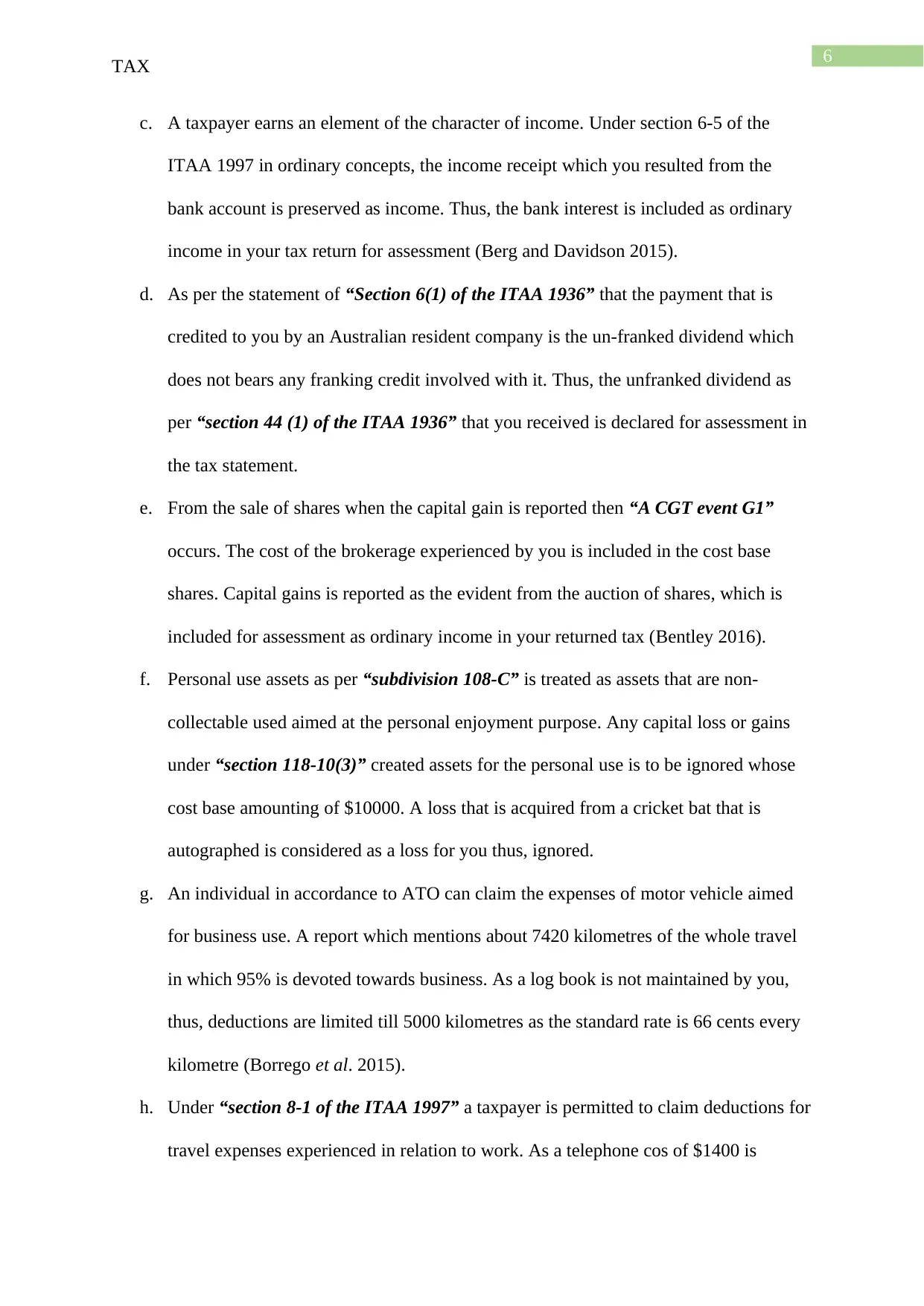
6
TAX
c. A taxpayer earns an element of the character of income. Under section 6-5 of the
ITAA 1997 in ordinary concepts, the income receipt which you resulted from the
bank account is preserved as income. Thus, the bank interest is included as ordinary
income in your tax return for assessment (Berg and Davidson 2015).
d. As per the statement of “Section 6(1) of the ITAA 1936” that the payment that is
credited to you by an Australian resident company is the un-franked dividend which
does not bears any franking credit involved with it. Thus, the unfranked dividend as
per “section 44 (1) of the ITAA 1936” that you received is declared for assessment in
the tax statement.
e. From the sale of shares when the capital gain is reported then “A CGT event G1”
occurs. The cost of the brokerage experienced by you is included in the cost base
shares. Capital gains is reported as the evident from the auction of shares, which is
included for assessment as ordinary income in your returned tax (Bentley 2016).
f. Personal use assets as per “subdivision 108-C” is treated as assets that are non-
collectable used aimed at the personal enjoyment purpose. Any capital loss or gains
under “section 118-10(3)” created assets for the personal use is to be ignored whose
cost base amounting of $10000. A loss that is acquired from a cricket bat that is
autographed is considered as a loss for you thus, ignored.
g. An individual in accordance to ATO can claim the expenses of motor vehicle aimed
for business use. A report which mentions about 7420 kilometres of the whole travel
in which 95% is devoted towards business. As a log book is not maintained by you,
thus, deductions are limited till 5000 kilometres as the standard rate is 66 cents every
kilometre (Borrego et al. 2015).
h. Under “section 8-1 of the ITAA 1997” a taxpayer is permitted to claim deductions for
travel expenses experienced in relation to work. As a telephone cos of $1400 is
TAX
c. A taxpayer earns an element of the character of income. Under section 6-5 of the
ITAA 1997 in ordinary concepts, the income receipt which you resulted from the
bank account is preserved as income. Thus, the bank interest is included as ordinary
income in your tax return for assessment (Berg and Davidson 2015).
d. As per the statement of “Section 6(1) of the ITAA 1936” that the payment that is
credited to you by an Australian resident company is the un-franked dividend which
does not bears any franking credit involved with it. Thus, the unfranked dividend as
per “section 44 (1) of the ITAA 1936” that you received is declared for assessment in
the tax statement.
e. From the sale of shares when the capital gain is reported then “A CGT event G1”
occurs. The cost of the brokerage experienced by you is included in the cost base
shares. Capital gains is reported as the evident from the auction of shares, which is
included for assessment as ordinary income in your returned tax (Bentley 2016).
f. Personal use assets as per “subdivision 108-C” is treated as assets that are non-
collectable used aimed at the personal enjoyment purpose. Any capital loss or gains
under “section 118-10(3)” created assets for the personal use is to be ignored whose
cost base amounting of $10000. A loss that is acquired from a cricket bat that is
autographed is considered as a loss for you thus, ignored.
g. An individual in accordance to ATO can claim the expenses of motor vehicle aimed
for business use. A report which mentions about 7420 kilometres of the whole travel
in which 95% is devoted towards business. As a log book is not maintained by you,
thus, deductions are limited till 5000 kilometres as the standard rate is 66 cents every
kilometre (Borrego et al. 2015).
h. Under “section 8-1 of the ITAA 1997” a taxpayer is permitted to claim deductions for
travel expenses experienced in relation to work. As a telephone cos of $1400 is
Paraphrase This Document
Need a fresh take? Get an instant paraphrase of this document with our AI Paraphraser
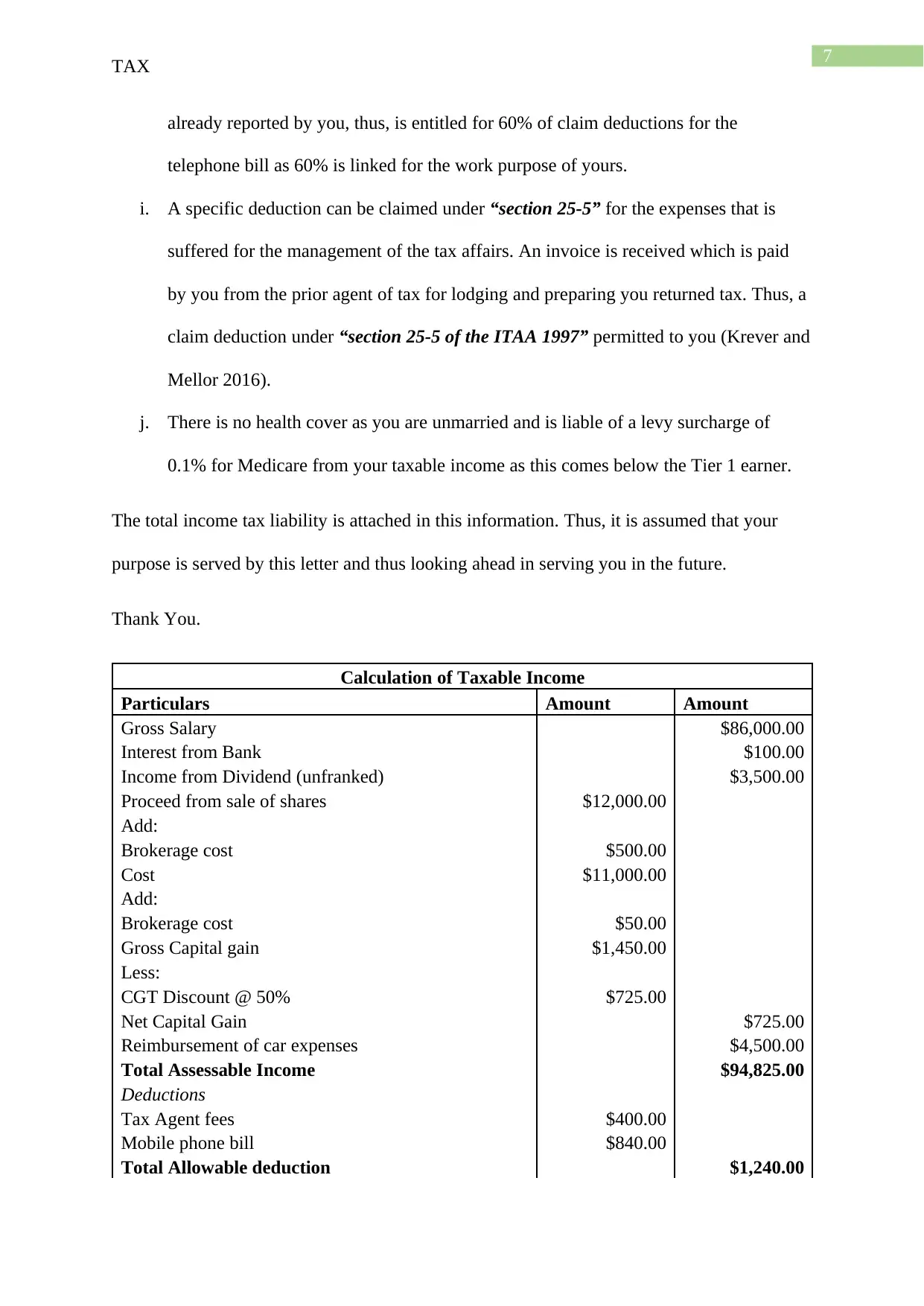
7
TAX
already reported by you, thus, is entitled for 60% of claim deductions for the
telephone bill as 60% is linked for the work purpose of yours.
i. A specific deduction can be claimed under “section 25-5” for the expenses that is
suffered for the management of the tax affairs. An invoice is received which is paid
by you from the prior agent of tax for lodging and preparing you returned tax. Thus, a
claim deduction under “section 25-5 of the ITAA 1997” permitted to you (Krever and
Mellor 2016).
j. There is no health cover as you are unmarried and is liable of a levy surcharge of
0.1% for Medicare from your taxable income as this comes below the Tier 1 earner.
The total income tax liability is attached in this information. Thus, it is assumed that your
purpose is served by this letter and thus looking ahead in serving you in the future.
Thank You.
Calculation of Taxable Income
Particulars Amount Amount
Gross Salary $86,000.00
Interest from Bank $100.00
Income from Dividend (unfranked) $3,500.00
Proceed from sale of shares $12,000.00
Add:
Brokerage cost $500.00
Cost $11,000.00
Add:
Brokerage cost $50.00
Gross Capital gain $1,450.00
Less:
CGT Discount @ 50% $725.00
Net Capital Gain $725.00
Reimbursement of car expenses $4,500.00
Total Assessable Income $94,825.00
Deductions
Tax Agent fees $400.00
Mobile phone bill $840.00
Total Allowable deduction $1,240.00
TAX
already reported by you, thus, is entitled for 60% of claim deductions for the
telephone bill as 60% is linked for the work purpose of yours.
i. A specific deduction can be claimed under “section 25-5” for the expenses that is
suffered for the management of the tax affairs. An invoice is received which is paid
by you from the prior agent of tax for lodging and preparing you returned tax. Thus, a
claim deduction under “section 25-5 of the ITAA 1997” permitted to you (Krever and
Mellor 2016).
j. There is no health cover as you are unmarried and is liable of a levy surcharge of
0.1% for Medicare from your taxable income as this comes below the Tier 1 earner.
The total income tax liability is attached in this information. Thus, it is assumed that your
purpose is served by this letter and thus looking ahead in serving you in the future.
Thank You.
Calculation of Taxable Income
Particulars Amount Amount
Gross Salary $86,000.00
Interest from Bank $100.00
Income from Dividend (unfranked) $3,500.00
Proceed from sale of shares $12,000.00
Add:
Brokerage cost $500.00
Cost $11,000.00
Add:
Brokerage cost $50.00
Gross Capital gain $1,450.00
Less:
CGT Discount @ 50% $725.00
Net Capital Gain $725.00
Reimbursement of car expenses $4,500.00
Total Assessable Income $94,825.00
Deductions
Tax Agent fees $400.00
Mobile phone bill $840.00
Total Allowable deduction $1,240.00
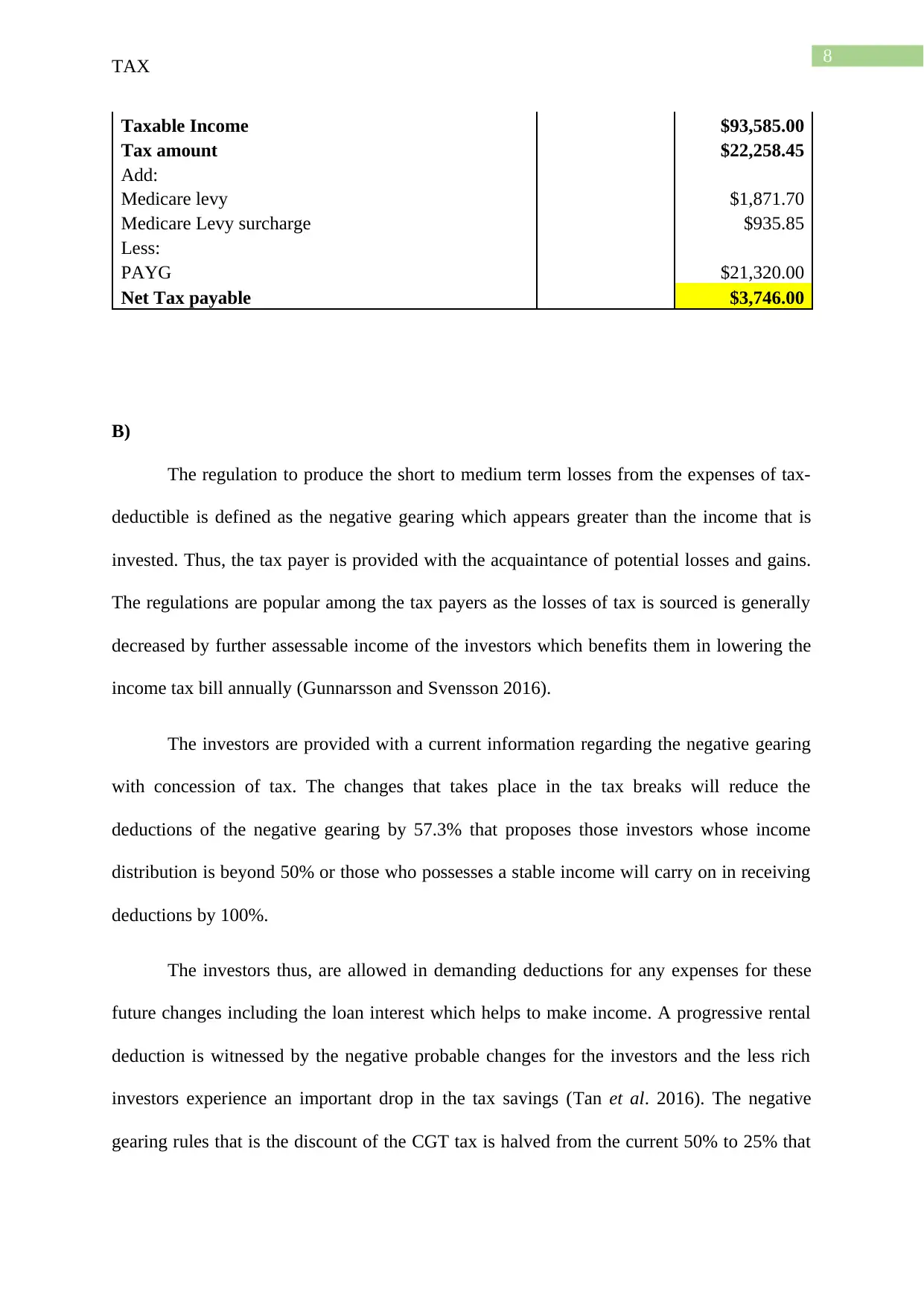
8
TAX
Taxable Income $93,585.00
Tax amount $22,258.45
Add:
Medicare levy $1,871.70
Medicare Levy surcharge $935.85
Less:
PAYG $21,320.00
Net Tax payable $3,746.00
B)
The regulation to produce the short to medium term losses from the expenses of tax-
deductible is defined as the negative gearing which appears greater than the income that is
invested. Thus, the tax payer is provided with the acquaintance of potential losses and gains.
The regulations are popular among the tax payers as the losses of tax is sourced is generally
decreased by further assessable income of the investors which benefits them in lowering the
income tax bill annually (Gunnarsson and Svensson 2016).
The investors are provided with a current information regarding the negative gearing
with concession of tax. The changes that takes place in the tax breaks will reduce the
deductions of the negative gearing by 57.3% that proposes those investors whose income
distribution is beyond 50% or those who possesses a stable income will carry on in receiving
deductions by 100%.
The investors thus, are allowed in demanding deductions for any expenses for these
future changes including the loan interest which helps to make income. A progressive rental
deduction is witnessed by the negative probable changes for the investors and the less rich
investors experience an important drop in the tax savings (Tan et al. 2016). The negative
gearing rules that is the discount of the CGT tax is halved from the current 50% to 25% that
TAX
Taxable Income $93,585.00
Tax amount $22,258.45
Add:
Medicare levy $1,871.70
Medicare Levy surcharge $935.85
Less:
PAYG $21,320.00
Net Tax payable $3,746.00
B)
The regulation to produce the short to medium term losses from the expenses of tax-
deductible is defined as the negative gearing which appears greater than the income that is
invested. Thus, the tax payer is provided with the acquaintance of potential losses and gains.
The regulations are popular among the tax payers as the losses of tax is sourced is generally
decreased by further assessable income of the investors which benefits them in lowering the
income tax bill annually (Gunnarsson and Svensson 2016).
The investors are provided with a current information regarding the negative gearing
with concession of tax. The changes that takes place in the tax breaks will reduce the
deductions of the negative gearing by 57.3% that proposes those investors whose income
distribution is beyond 50% or those who possesses a stable income will carry on in receiving
deductions by 100%.
The investors thus, are allowed in demanding deductions for any expenses for these
future changes including the loan interest which helps to make income. A progressive rental
deduction is witnessed by the negative probable changes for the investors and the less rich
investors experience an important drop in the tax savings (Tan et al. 2016). The negative
gearing rules that is the discount of the CGT tax is halved from the current 50% to 25% that
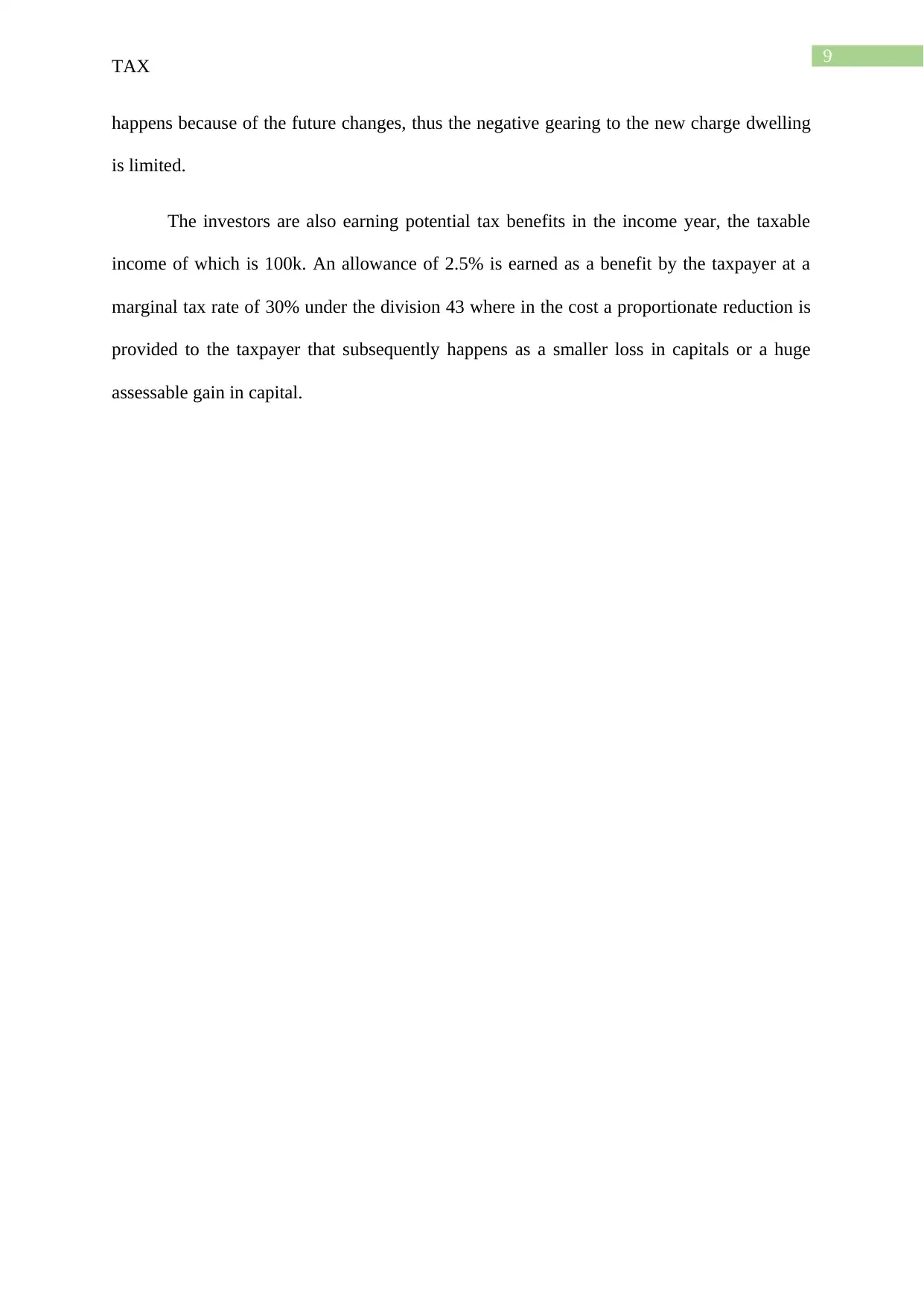
9
TAX
happens because of the future changes, thus the negative gearing to the new charge dwelling
is limited.
The investors are also earning potential tax benefits in the income year, the taxable
income of which is 100k. An allowance of 2.5% is earned as a benefit by the taxpayer at a
marginal tax rate of 30% under the division 43 where in the cost a proportionate reduction is
provided to the taxpayer that subsequently happens as a smaller loss in capitals or a huge
assessable gain in capital.
TAX
happens because of the future changes, thus the negative gearing to the new charge dwelling
is limited.
The investors are also earning potential tax benefits in the income year, the taxable
income of which is 100k. An allowance of 2.5% is earned as a benefit by the taxpayer at a
marginal tax rate of 30% under the division 43 where in the cost a proportionate reduction is
provided to the taxpayer that subsequently happens as a smaller loss in capitals or a huge
assessable gain in capital.
Secure Best Marks with AI Grader
Need help grading? Try our AI Grader for instant feedback on your assignments.
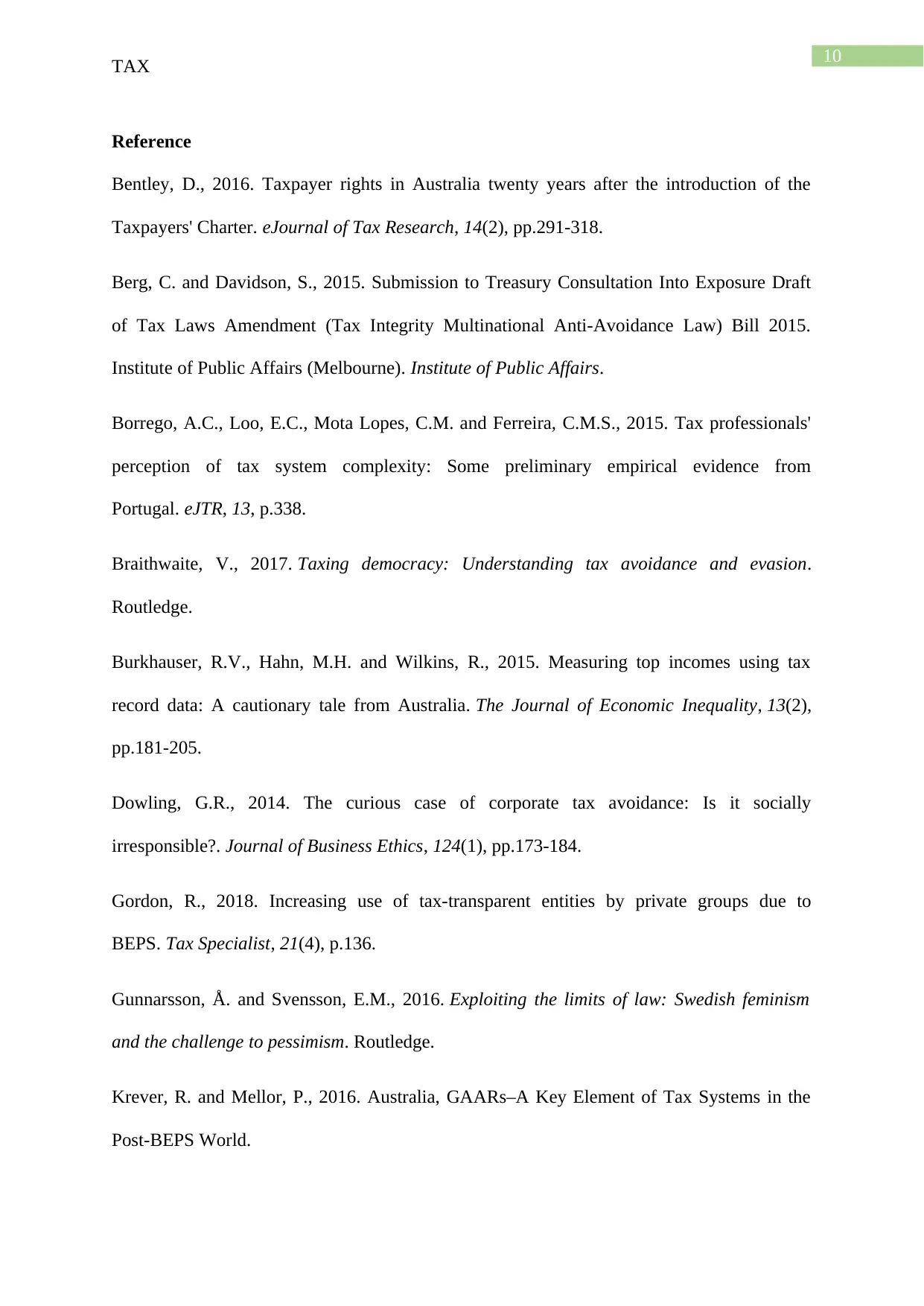
10
TAX
Reference
Bentley, D., 2016. Taxpayer rights in Australia twenty years after the introduction of the
Taxpayers' Charter. eJournal of Tax Research, 14(2), pp.291-318.
Berg, C. and Davidson, S., 2015. Submission to Treasury Consultation Into Exposure Draft
of Tax Laws Amendment (Tax Integrity Multinational Anti-Avoidance Law) Bill 2015.
Institute of Public Affairs (Melbourne). Institute of Public Affairs.
Borrego, A.C., Loo, E.C., Mota Lopes, C.M. and Ferreira, C.M.S., 2015. Tax professionals'
perception of tax system complexity: Some preliminary empirical evidence from
Portugal. eJTR, 13, p.338.
Braithwaite, V., 2017. Taxing democracy: Understanding tax avoidance and evasion.
Routledge.
Burkhauser, R.V., Hahn, M.H. and Wilkins, R., 2015. Measuring top incomes using tax
record data: A cautionary tale from Australia. The Journal of Economic Inequality, 13(2),
pp.181-205.
Dowling, G.R., 2014. The curious case of corporate tax avoidance: Is it socially
irresponsible?. Journal of Business Ethics, 124(1), pp.173-184.
Gordon, R., 2018. Increasing use of tax-transparent entities by private groups due to
BEPS. Tax Specialist, 21(4), p.136.
Gunnarsson, Å. and Svensson, E.M., 2016. Exploiting the limits of law: Swedish feminism
and the challenge to pessimism. Routledge.
Krever, R. and Mellor, P., 2016. Australia, GAARs–A Key Element of Tax Systems in the
Post-BEPS World.
TAX
Reference
Bentley, D., 2016. Taxpayer rights in Australia twenty years after the introduction of the
Taxpayers' Charter. eJournal of Tax Research, 14(2), pp.291-318.
Berg, C. and Davidson, S., 2015. Submission to Treasury Consultation Into Exposure Draft
of Tax Laws Amendment (Tax Integrity Multinational Anti-Avoidance Law) Bill 2015.
Institute of Public Affairs (Melbourne). Institute of Public Affairs.
Borrego, A.C., Loo, E.C., Mota Lopes, C.M. and Ferreira, C.M.S., 2015. Tax professionals'
perception of tax system complexity: Some preliminary empirical evidence from
Portugal. eJTR, 13, p.338.
Braithwaite, V., 2017. Taxing democracy: Understanding tax avoidance and evasion.
Routledge.
Burkhauser, R.V., Hahn, M.H. and Wilkins, R., 2015. Measuring top incomes using tax
record data: A cautionary tale from Australia. The Journal of Economic Inequality, 13(2),
pp.181-205.
Dowling, G.R., 2014. The curious case of corporate tax avoidance: Is it socially
irresponsible?. Journal of Business Ethics, 124(1), pp.173-184.
Gordon, R., 2018. Increasing use of tax-transparent entities by private groups due to
BEPS. Tax Specialist, 21(4), p.136.
Gunnarsson, Å. and Svensson, E.M., 2016. Exploiting the limits of law: Swedish feminism
and the challenge to pessimism. Routledge.
Krever, R. and Mellor, P., 2016. Australia, GAARs–A Key Element of Tax Systems in the
Post-BEPS World.
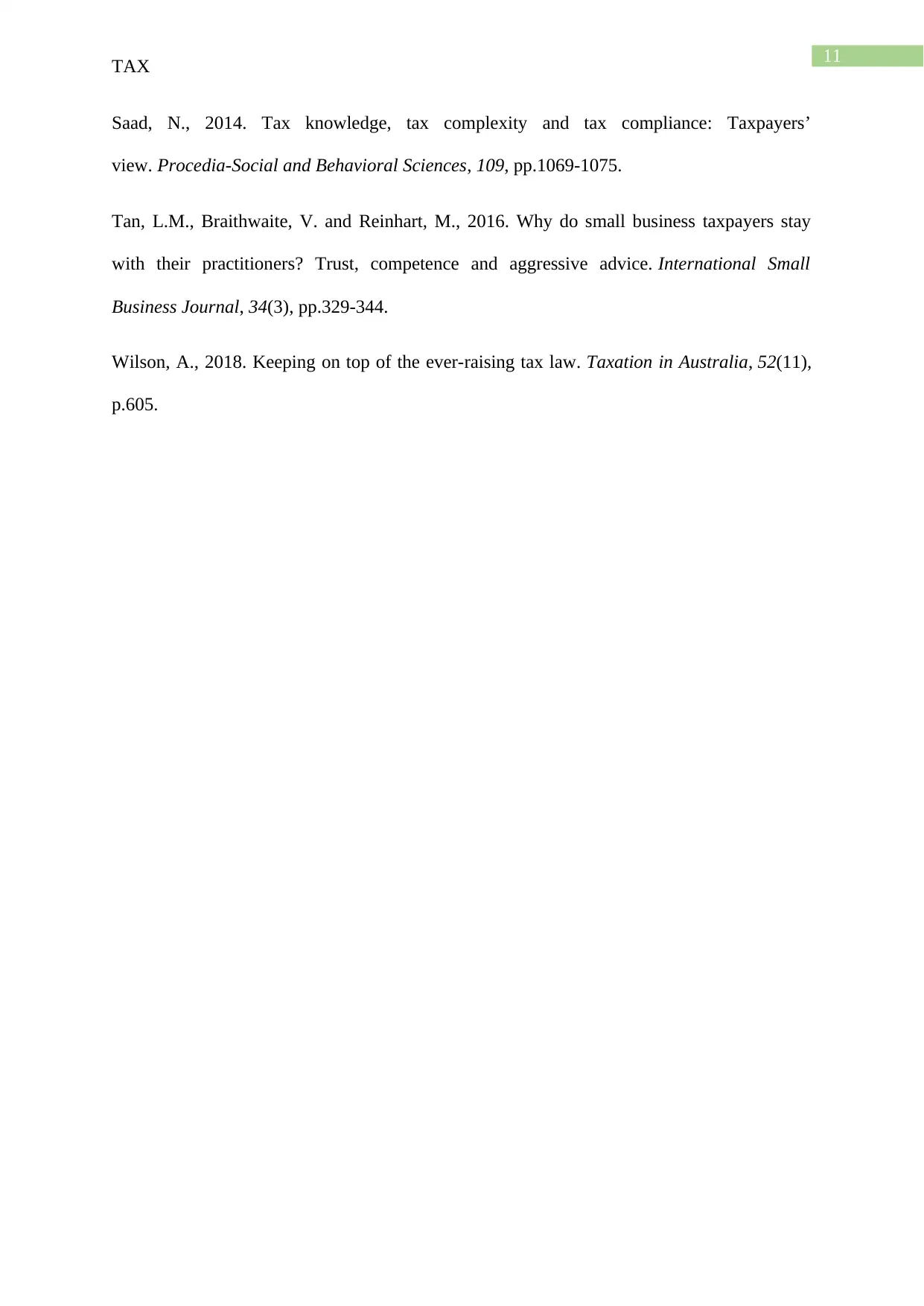
11
TAX
Saad, N., 2014. Tax knowledge, tax complexity and tax compliance: Taxpayers’
view. Procedia-Social and Behavioral Sciences, 109, pp.1069-1075.
Tan, L.M., Braithwaite, V. and Reinhart, M., 2016. Why do small business taxpayers stay
with their practitioners? Trust, competence and aggressive advice. International Small
Business Journal, 34(3), pp.329-344.
Wilson, A., 2018. Keeping on top of the ever-raising tax law. Taxation in Australia, 52(11),
p.605.
TAX
Saad, N., 2014. Tax knowledge, tax complexity and tax compliance: Taxpayers’
view. Procedia-Social and Behavioral Sciences, 109, pp.1069-1075.
Tan, L.M., Braithwaite, V. and Reinhart, M., 2016. Why do small business taxpayers stay
with their practitioners? Trust, competence and aggressive advice. International Small
Business Journal, 34(3), pp.329-344.
Wilson, A., 2018. Keeping on top of the ever-raising tax law. Taxation in Australia, 52(11),
p.605.
1 out of 12
Related Documents
Your All-in-One AI-Powered Toolkit for Academic Success.
+13062052269
info@desklib.com
Available 24*7 on WhatsApp / Email
![[object Object]](/_next/static/media/star-bottom.7253800d.svg)
Unlock your academic potential
© 2024 | Zucol Services PVT LTD | All rights reserved.





